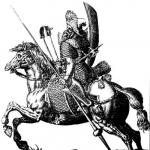The main periods of illness. Periods and complications of infectious disease Serological examination for abdominal title
At any clinically manifest infectious disease distinguish the following periods:
1. Incubation (hidden) period (IP);
2. The period of precursors, or the long period;
3. The period of the main manifestations of the disease;
4. Failure period (decline in clinical manifestations) of the disease;
5. The recovery period (reconvaluescence: early and late, with residual phenomena or without them).
Incubation period - This is the time passing from the moment of infection until the first signs of the disease. With each infectious disease, the IP has its duration, sometimes strictly defined, sometimes fluctuating, so it is customary to allocate the average duration of the PI with each of them. During this period, the reproduction of the pathogen and the accumulation of toxins to a critical value occur when the first clinical manifestations of the disease arise according to the microbial type. During the IP, complex processes occur on the speaker and cellular levels, but there is still no organ and system manifestations Diseases.
Period The harbents, or the long period, are observed not at all infectious diseases and lasts usually 1-2-3 days. It is characterized by initial painful manifestations that do not have any characteristic clinical traits characteristic of a certain infectious disease. Complaints of patients during this period are general ailment, small headache, pain and lubrication in the body, cognition and moderate fever.
Period The main manifestations of the disease, the so-called "stationary" period, in turn can be divided into the growth rate of painful phenomena, the period of the sickness of the disease and its recession. During the rise and rank of disease appear in a certain sequence (stage), the main clinical manifestations characterizing it as an independent clinically outlined disease. During the periods of rapidness and rapidness of the disease in the body of the disease, the maximum accumulation of the pathogen and its associated toxic substances is occurring: ex- and endotoxins, as well as nonspecific factors of intoxication and inflammation. The effect of exotoxins on the human body compared with endotoxins is more determined, sometimes clearly local, with the damage inherent in this disease the anatomical structures of organs and tissues. The action of various endotoxins, although less differentiable, can still differ in different diseases not only in severity, but also some features.
For example, headache with endotoxic intoxication May have some shades in the form of differences in character and severity, constancy or periodicity, strengthening and weakening at different times of day, patient portability, etc.
In that period Along with the previously described biochemical and other shifts associated with endogenous intoxication, There is a whole cascade of changes caused by poisonous substances endogenous, to that harmless, the organism's own microflora (autofloro) and the accumulation of substances arising from enzymatic, most often proteolytic decay of cells and body tissues (for example, with toxic hepatodine). As a result of the compound of the toxic substances of an exogenous microbe, which caused the disease, and endogenous microflora with proteins of own tissues (microb + fabric, toxic agent + fabric), autoantirates are formed - carriers of alien information, to which the body meets the production of autoantibodies to its own tissues ("its own Clear "), acquiring pathogenic importance (beginning," start "and the development of autoimmune reactions).
They possess partially and some physiological role (Normal isoantigens and isoagratibe by P.N. Kosyakov), but their main importance in the conditions of infectious disease is a cytopathic effect on its own cells and tissues (immunopathological reactions, for example, with hepatitis B). Under the action of leukocidins and hemolysins of pathogenic microorganisms (for example, staphylococci and streptococci), erythrocyte and leukocytes are lysis with the formation of endogenous pyrogenic substances. Along with endotoxins of bacteria, these substances lead to an increase in body temperature (fever). The fevering reaction of the body, which arises in response to the pathogenic effect of various types of microbes, is not the same, which underlies the formation of various types of fever peculiar to a certain IB.
In its formation participate Complex mechanisms of neurogormonal regulation of human heat exchange and related to these impacts of changes in central and vegetative nervous regulation. From the very beginning of this period of the disease, the chills appears (sympathetic "storm"), the number of heart abbreviations (heart rate) increases, and later decreases arterial pressure (Hell) and many other changes arise. Under a number of IB, the state is developing, referred to as typhoid (Status Typhosus): the patient becomes drowned, sluggish, indifferent to the surrounding, sometimes loses consciousness, delight and dreams of various color and content appear. Sometimes there are motor excitement, inadequate mental reactions, disorientation in time and space. During the rank of illness, symptoms are typical for this infectious disease, changes in peripheral blood, as well as general manifestations (increase in liver and spleen, change the pulse rate in the form of tachycardia or relative bradycardia, arterial hypertension, and then hypotension, up to the collapse, changes to the ECG), there are local manifestations: a rash on the skin (examine) and the mucous membranes of the mouth (Enanthema), dryness of the mucous membranes, language calculations, constipation or chairs, increase lymph nodes and etc.
With different infectious diseases Periods of increment and midstings of the disease have an unequal duration: from several hours (food toxicoinfection) and several days (chiegelosis, salmonellosis, cholera, plague, etc.) up to one week (Tiffs, hepatitis A) or a few weeks, rarely up to month or more ( Brucellosis, viral hepatitis B and C, Iraciniosis, etc.). In most cases, they end with recovery. Nowadays, fatal outcomes are rare, but still take place (tetanus, botulism, meningococcal infection, viral hepatitis In, hemorrhagic fever, septic forms of salmonellosis, flu in the elderly and old people, etc.).
In the development of the disease, four periods (stages) are usually distinguished: latent, longitudinal, period of sickness of the disease and the outcome, or the period of the end of the disease. Such periodization has developed in the past with a clinical analysis of acute infectious diseases (abdominal typhoid, scarlet nature, etc.). Other diseases (cardiovascular, endocrine, tumors) are developing according to other laws, and therefore, the above periodization is apprehensible to them. A. D. ADO allocates three stages of the development of the disease: the beginning, the stage of the disease itself, the outcome.
Latent period (in relation to infectious diseases - incubation) lasts from the moment of exposure to the cause before the appearance of the first clinical signs of the disease. This period may be short, as under the action of combat poisoning substances, and very long, as for pumping (several years). During this period, the defensive forces of the body, aimed at compensating for possible disorders, on the destruction of pathogens or to remove them from the body. Features of the latent period It is important to know when conducting preventive measures (insulation in case of infection), as well as for treatment, often efficiently effective in this period (rabies).
Promotional period - This is a segment of the time from the first signs of the disease to the complete manifestation of its symptoms. Sometimes this period is manifested by bright (brunt pneumonia, dysentery), in other cases it is characterized by the presence of weak, but clear signs of the disease. With mountainous disease, for example, it is an unfortunate fun (euphoria), during Corey - Wielsky spots - Sokilika - Filatova, etc. All this is important for differential diagnosis. At the same time, the allocation of the prodromal period with many chronic diseases is often difficult.
Period of pronounced manifestations, or sickness of the disease, is characterized by full development clinical picture: cramps in case of lack of parathyroid glands, leukopenia with radiation sickness, typical triad (hyperglycemia, glycosuria, polyuria) with diabetes mellitus. The duration of this period for a number of diseases (bruboral pneumonia, cortex) is determined relatively easily. For chronic diseases With their slow current change of periods of elusive. With such diseases such as tuberculosis, syphilis, the asymptomatic flow of the process alternates with its exacerbation, and new exacerbations are sometimes noticeably different from the primary manifestations of the disease.
Exodus of the disease. The following outcomes of the disease are observed: recovery (full and incomplete), relapse, the transition to a chronic form, death.
Recovery - The process that leads to the elimination of disorders caused by the disease and the restoration of the normal relations of the body with the medium, in humans - primarily to disability.
Recovery is complete and incomplete. Full recovery - This is a condition in which all traces of the disease disappear and the body completely restores its adaptive capabilities. Recovery does not always mean return to the initial state. As a result, the disease may appear and continue to change from various systems, including immune.
With incomplete recovery The consequences of the disease are expressed. They stay for a long time or even forever (the battle of sheets of pleura, narrowing of the mitral hole). The difference between full and incomplete recovery is relative. Recovery can be practically complete, despite the resistant anatomical defect (for example, the absence of one kidney, if the second fully compensates for its function). It should not be thought that the recovery begins after the preceding stages of the disease passed. The process of recovery begins from the moment of the occurrence of the disease.
The idea of \u200b\u200bthe recovery mechanisms is formed on the basis of the general provision that the disease is the unity of two opposite phenomena - actually pathological and protective compensatory. The predominance of one of them solves the outcome of the disease. The recovery occurs when the complex of adaptive reactions turns out to be sufficiently strong to compensate for possible violations. From recovery mechanisms, urgent (emergency) and long-term are distinguished. Urgent reflexive protective reactions such as changes in respiratory frequency and heart abbreviations, the release of adrenaline and glucocorticoids during stressful reactions, as well as all the mechanisms that are aimed at preserving the constancy of the inner medium (pH, blood glucose content, blood pressure, etc. d.). Long-term reactions are developing slightly later and operated throughout the disease. This is primarily the inclusion of the reserve features of functional systems. Sugar diabetes does not occur with the loss of even 3/4 pancreatic islands. A person can live with one light, with one kidney. A healthy heart with a load can perform work five times greater than at rest.
The enhancement of the function increases not only due to the inclusion of previously worked structural-functional units of organs (for example, nephrons), but also as a result of increasing the intensity of their work, which in turn causes the activation of plastic processes and an increase in body mass (hypertrophy) to a level when the load On each functioning unit does not exceed normal.
The inclusion of compensatory mechanisms, as well as the termination of their activities, is primarily dependent on the nervous system. P. K. Anokhin formulated an idea of \u200b\u200bfunctional systems specifically compensating for a functional defect caused by damage. These functional systems are formed and operate according to certain principles:
Alarm on the impaired impairment leading to the inclusion of the corresponding compensatory mechanisms.
Progressive mobilization of spare compensatory mechanisms.
Reverse affamentation of consecutive stages of recovery of disturbed functions.
The formation of such a combination of excitations in the central nervous system, which determines the successful restoration of functions in the peripheral organ.
Evaluation of the adequacy and strength of final compensation in the dynamics.
The disintegration of the system as unnecessary.
The sequence of compensation steps can be traced on the example of a chromotype during the damage to one foot:
alarm on the violation of equilibrium from the predver-snelled organ;
restructuring the work of motor centers and muscle groups in order to preserve the balance and possibility of movement;
a constant combination of afferentations entering the highest departments of the central nervous system and the formation of temporary connections that provide optimal compensation, i.e., the possibility of walking with a minimum chromota is also caused by a stable anatomical defect.
Recurd - A new manifestation of the disease after the apparent or incomplete cessation, for example, the resumption of malaria seizures after a more or less long interval. There are relapses of lung inflammation, colitis, etc.
Chronic form It means that the disease proceeds slowly, with long periods of remission (months and even years). This course of the disease is determined by the virulence of the pathogen and mainly the reactivity of the body. So, at the old age, many diseases acquire chronic character (chronic pneumonia, chronic colitis).
Terminal states - The gradual cessation of life even, seemingly instant death. It means that death is a process, and several stages (terminal states) can be distinguished in this process: the preagonia, agony, clinical and biological death.
Preagony May be different duration (hours, day). During this period, shortness of breath is observed, reduced blood pressure (up to 7.8 kPa - 60 mm Hg. Art. And below), tachycardia. A person has dimming consciousness. Gradually, pregnonia goes into agony.
Agony (from Greek. Agon - Fight) is characterized by gradually shutting down all the functions of the body and at the same time the extreme tension of the protective mechanisms, losing its feasibility (convulsions, terminal breathing). Duration of agony - 2 - 4 min, sometimes more.
The clinical death is called such a fortune when all visible signs of life have already disappeared (the breath and the work of the heart stopped, but the metabolism, although the minimum, is still continuing). At this stage, life can be restored. That is why the stage of clinical death attracts special attention to clinicians and experimenters.
Biological death is characterized by irreversible changes in the body.
Animal experiences, primarily on dogs, allowed to study the functional, biochemical and morphological changes in detail at all stages of dying.
The dying is the disintegration of the body's integrity. It ceases to be a self-regulating system. At the same time, the systems that combine the body into a single whole are destroyed, first of all - nervous system. In the same time lower levels Regulation is preserved to some extent. In turn, there is a certain sequence of dying of various departments of the nervous system. Most sensitive to hypoxia bark big Brain. When asphyxia or with acute blood loss, the neurons are first observed. In this regard, there is a motor excitement, the increase in respiration and pulse, an increase in blood pressure. Then there is a braking in a cortex that has a protective value, since for a certain period there can be kept cells from death. With further dying, the excitation process, and then braking and exhaustion extends below, on the stem part of the brain and on the reticular pharmacy. These phylogenetically more ancient brain departments are most resistant to oxygen starvation (the centers of the oblong brain can carry hypoxia for 40 minutes).
In the same sequence, changes in other organs and systems occur. In case of mortal blood loss, for example, in the first minute, breathing is sharply deepened and is expelled. Then the rhythm is broken, the breaths become very deep, then superficial. Finally, the excitation of the respiratory center reaches the maximum, which is manifested by a particularly deep breathing, which has a pronounced inspiratory character. After that, breathing is weakened or even suspended. This terminal pause lasts 30.- 60 s. The breath is then temporarily renewed, acquiring the nature of rare, first deep, and then more and more superficial sighs. Along with the respiratory center is activated by vasodent. The tone of the vessels increases, the reduction of the heart is enhanced, but soon the tone of the vessels decreases.
It is important to note that after stopping the work of the heart, the system generating excitement continues to function for another long time. The ECG biotoks are noted within 30 - 60 minutes after the disappearance of the pulse.
In the process of dying, characteristic changes in metabolism occur, due to the mainly in-depth oxygen starvation. Oxidative paths of metabolism are blocked, and the body gets energy due to glycolysis. The inclusion of this ancient type of metabolism has a compensatory value, but its low efficiency inevitably leads to decompensation, aggravating acidosis. Clinical death comes. Breath stops, blood circulation, reflexes disappear, but the metabolism, although at a very low level, is still going on. This is enough to maintain the "minimum life" of nerve cells. This explains the reversibility of the clinical death process, i.e., in this period there is a revival.
Very important is the question of timing, during which resuscitation is possible and appropriate. After all, the revival is justified only in the case of recovery of mental activities. V. A. Nehovsky and other researchers argue that positive results can be achieved no later than 5 - 6 minutes after the start of clinical death. If the process of dying continues for a long time, leading to the depletion of creatine phosphate and ATP reserves, then the period of clinical death is still shorter. On the contrary, with hypothermia, the revival is possible even an hour after the coming of clinical death. In the laboratory N. N. Sirotinin, it was shown to revive the dog in 20 minutes after death as a result of bleeding with the subsequent full recovery of mental activity. It should, however, be borne in mind that in the human brain hypoxia causes great changes than in the brain in animals.
Resuscitation, or recovery, the body includes a number of activities that are directed primarily to the restoration of blood circulation and respiration: heart massage, artificial ventilation of the lungs, heart defibrillation. The last event requires the presence of appropriate equipment and can be carried out in special conditions.
Etiology. The concept of the causes and conditions of the occurrence of the disease. Classification of causes of diseases. The role of heredity and the constitution in the emergence and development of the disease.
Incubation- Since the introduction of an infectious agent to the body and before the start of clinical manifestations.
Premonitory- from the first clinical manifestations ( subfebrile temperature, ailment, weakness, headache, etc.).
The period of the main (pronounced) clinical manifestations (the height of the disease)- The most significant for diagnostics specific clinical and laboratory symptoms and syndromes.
Period of extinction of clinical manifestations.
Reconvancement period- cessation of the reproduction of the pathogen in the patient's body, the death of the pathogen and the complete restoration of homeostasis.
Sometimes on the background of clinical recovery, the carriage begins to form - acute (up to 3 months), protracted (up to 6 months), chronic (more than 6 months).
Forms of the infectious process.
By origin:
Exogenous infection- after infection with microorganism from the outside
Endogenous infection- caused by microgenisms located in the very body.
On the localization of the pathogen:
Focal- The causative agent remains at the entrance gate and does not apply to the body.
Gene. ralized- The causative agent of distributing the body of lymphogenic, hematogenically, perioreural.
Bacteremia- Microorganism is in the blood for some time, without multiplying in it.
Septicemia (sepsis)- Blood is a permanent habitat of microorganisms and their reproduction.
Toxinemia (antigemia)- admission to the blood of antigens and toxins of bacteria.
According to the number of pathogens:
Monoinfection is caused by one type of microorganisms.
Mixed (MIXT) - several species simultaneously cause a disease.
According to the repeated appearance of the disease caused by the same or other pathogens:
Secondary infection - to an already developed disease caused by one type of microorganisms, an new infectious process is joined, caused by another type of microorganism (s).
Superinfection is a re-infection of a patient with the same microorganism with the enhancement of the clinical picture of this period of the disease.
Reinfection - re-infection with the same type of microorganism after recovery.
Epidemic Process- The process of the occurrence and distribution of specific infectious states caused by the circulator circulating in the team.
Units of the epidemic process:
Source infection
Mechanism and transmission
Susceptible team
Classification by the source of infection:
1. Anthroponous infection - Only a person serves as a source of infection.
2. Zoonogenic infections - The source is sick animals, but a person can be sick.
3. Sapronous infections - The source of the infection is environmental objects.
Mechanism of transmission- A method of moving the pathogen from an infected organism into susceptible.
Carried out in 3 phases:
1. Disagreement of the pathogen from the host organism
2. Stay in environmental objects
3. The introduction of the pathogen into a susceptible organism.
Break: fecal-oral, aerogenic (respiratory), blood (transmissive), contact, vertical (from mother to the fetus).
Ways transfer- Elements of the external environment or a combination of their combination of microorganism from one macroorganism to another.
|
Localization of pathogens in the body |
Mechanism of transmission |
Ways transfer |
Transmission factors |
|
Fecal-oral |
Alimentary Contact-household |
Dirty hands, dishes |
|
|
Respiratory tract |
Aerogenic (respiratory) |
Air-drip Air-dusty | |
|
Blood |
Through the bits of bloodsowing insects, etc. Parenteral |
Syringes, surgical instruments, infusion solutions, etc. |
|
|
Outdoor courses |
Contact |
Contact-sex |
Cutting items, bullets, etc. |
|
Germinal cells |
Vertical |
Classification according to the degree of intensity of the epidemic process.
Sporadic morbidity - The usual incidence rate of this nosological form in this area in this historical period of time.
Epidemic - The incidence rate of this nosological form in a given territory into a particular period of time, sharply higher than the level of sporadic morbidity.
Pandemic - The incidence rate of this nosological form in a given territory into a particular period of time, sharply exceeding the level of the epidemic.
Epidemics classification:
Natural focus - related to natural conditions and the range of distribution of tanks and carriers of infection (eg, plague).
Statistical - due to a complex of climate-geographical and socio-economic factors (eg, cholera in India and Bangladesh).
Infectious diseases have certain periods, or phases.
● Incubation (hidden) period - time when an infect enters the body and passes the cycle of its development, including reproduction. The duration of the period depends on the characteristics of the pathogen. At this time, there are still no subjective sensations of the disease, but there are already reactions between the infections and the body, the mobilization of the body's protective forces, a change in homeostasis, the strengthening of oxidative processes in tissues, allergies and hypersensitivity are growing.
● Promotional, or initial period of the disease. The first unclear symptoms of the disease are characteristic: malaise, often chills, headache, small muscle and articular pain. In the field of entrance gates, inflammatory changes are often occurring, moderate hyperplasia of lymph nodes and spleen. The duration of this period is 1-2 days. Upon reaching higher Level Hyperergia comes the next period.
● The period of the main manifestations of the disease. The symptoms of a particular infectious disease and characteristic morphological changes are clearly expressed. This period has the following stages.
Stage of the increase in the manifestation of the disease.
Stage of the right, or the maximum expression of symptoms.
Stage of extinction of manifestations of the disease. This period reflects the beginning of the gypergia, indicates that the body managed to some extent to limit the infection and in the area of \u200b\u200bits localization, the specificity and intensity of infection are most pronounced. During this period, the disease can flow without complications or with complications, the death of the patient may occur. If this does not happen, the disease passes in the next period.
The period of the main manifestations of the disease reflects the beginning of reactivity reducing, indicates that the body managed to some extent to localize the infection. In the area of \u200b\u200bits localization, the specificity of infection is most bright. During this period, the development of complications, even the death of the patient is possible. If this does not happen, the next period of the disease occurs.
● The period of extinction of the disease is the gradual disappearance of clinical symptoms, temperature normalization and reparative processes.
● The reconvaluation period (recovery) may have different duration depending on the shape of the disease, its flow, the patient's state. Often clinical recovery does not coincide with full recovery Morphological damage, the latter often longer.
Recovery can be complete when all disturbed functions are restored and incomplete if there are residual phenomena (for example, after polio). In addition, after clinical recovery, there is a carriage of infection that is associated, obviously, with an insufficient immunity of recovering, improper treatment or other reasons. The carriage of the pathogens of a number of diseases is possible for years (for example, those who have suffered with malaria) and even a lifetime (near the abdominal typhoid). The carrier of causative agents of infections has a large epidemiological importance, since carriers that do not know about the allocation of microorganisms them can become an invalid source of infection of others, and sometimes - the source of the epidemic.
text_fields.
text_fields.
arrow_upward
Since the penetration of the causative agent into the body, a certain time, the name of the incubation (hidden) period, is taking place to the clinical manifestation of symptoms of the disease. Its duration is different. With some diseases (flu, botulism), it is calculated for hours, with others (rabies, viral hepatitis B) - weeks and even months, with slow infections - months and years. For most infectious diseases duration incubation period is 1-3 weeks.
The duration of the incubation period due to several factors. To some extent, it is associated with the virulence and the infecting dose of the pathogen. The incubation period is in short, the higher the virulence and more dose of the causative agent.
To propagate the microorganism, its reproduction, the production of toxic substances is necessary for a certain time. However, the main role belongs to the reactivity of the macroorganism, on which not only the possibility of infectious disease, but also the intensity and pace of its development.
Since the beginning of the incubation period, physiological functions are changing in the body. Having achieved a certain level, they are expressed in the form of clinical symptoms.
Promotional period, or the period of harbinger of the disease
text_fields.
text_fields.
arrow_upward
With the advent of the first clinical signs of the disease, the long period begins, or the period of precursors of the disease.
Symptoms of it (Disadvantaged, headache, breakdown, sleep disorder, decreased appetite, sometimes a slight increase in body temperature) is characteristic of many infectious diseases, and therefore establishing a diagnosis in this period causes great difficulties.
The exception is measles: Detection in the extended period of pathognomonic symptom (Bel's spots - Filatov - Sokilka) allows you to establish an accurate and final nosological diagnosis.
The duration of the rise in symptoms Usually does not exceed 2-4 days.
Period of fusion of the disease
text_fields.
text_fields.
arrow_upward
The rapid period has a different duration - from several days (measles, influenza) up to several weeks (with abdominal typhoid, viral hepatitis, brucellosis).
During the ranking period, the symptoms characteristic of this infectious form are most pronounced.
Period to extract the disease
text_fields.
text_fields.
arrow_upward
The height of the disease is replaced by a period of extinction of clinical manifestations, a period of recovery (reconvalue) comes to change.
The period of recovery (reconvaluescence) of the disease.
text_fields.
text_fields.
arrow_upward
The duration of the reconvalue period varies widely and is depending on the form of the disease, the severity of the flow, the effectiveness of therapy and many other reasons.
Recovery can be full when all the disturbed function is restored, or incomplete If residual (residual) phenomena persist.
Complications of the infectious process
text_fields.
text_fields.
arrow_upward
In any period of illness, complications are possible - specific and nonspecific.
Specific include complicationscaused by the pathogen of this disease and are a consequence of the unusual severity of a typical clinical picture and morphofunctional manifestations of infection (perforation of the intestinal ulcers in the abdominal title, the hepatic coma in viral hepatitis) or the atypical localization of tissue damage (salmonellular endocarditis).
Complications caused by microorganisms of another species are not specific for this disease.An exceptional importance in the clinic of infectious diseases is hazardous to life complications requiring urgent interference, intensive observation and intensive therapy. These include liver coma (viral hepatitis), acute renal failure (malaria, leptospirosis, hemorrhagic fever With renal syndrome, meningococcal infection), pulmonary edema (influenza), brain swelling (fulminant hepatitis, meningitis), and shock.
In infectious practice there are the following types of shock:
- circulatory (infectious-toxic, toxic-infectious),
- hypovolemic
- hemorrhagic,
- anaphylactic.






